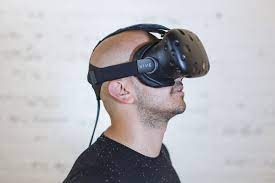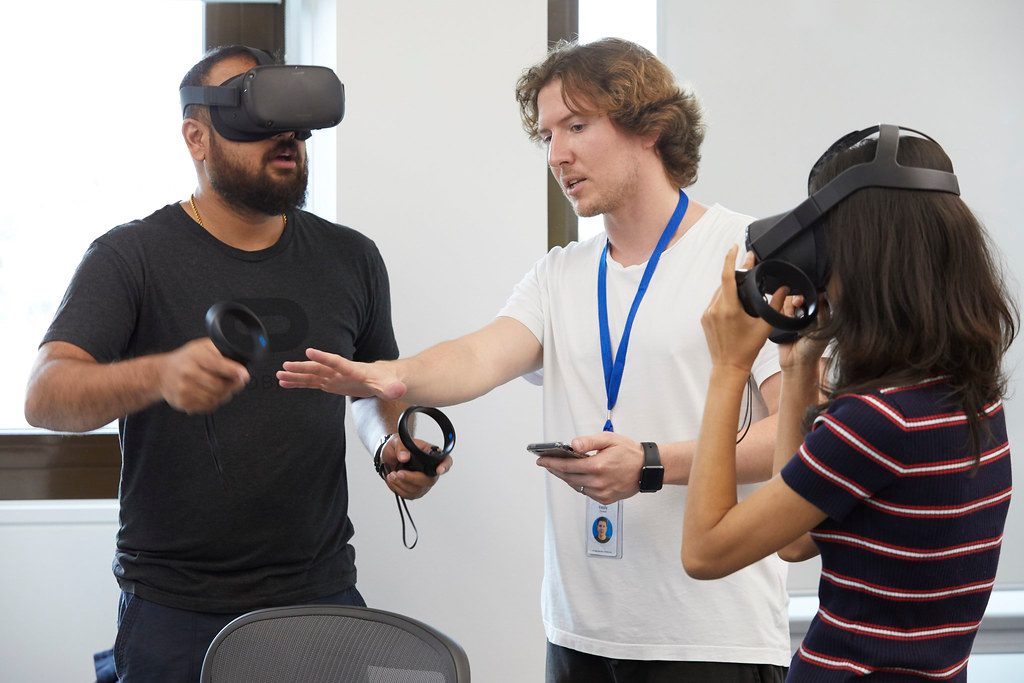Phobias are a type of anxiety disorder that can significantly impact a person’s quality of life. Traditional treatment options such as medication and talk therapy have proven effective. However, there is a growing interest in virtual reality (VR) therapy as an alternative treatment option. In this blog, we will explore the benefits and potential of VR for phobias. We will also discuss its working and various phobias that VR helps with.
Contents
What Is VR?
 VR stands for Virtual Reality. It is an immersive technology that allows users to experience a simulated environment through a head-mounted display or other devices. This technology creates a 3D environment that can be explored and interacted with, giving the user a sense of presence and immersion. VR is used in a variety of industries, including entertainment, gaming, education, healthcare, and more. It is rapidly advancing with new hardware and software innovations.
VR stands for Virtual Reality. It is an immersive technology that allows users to experience a simulated environment through a head-mounted display or other devices. This technology creates a 3D environment that can be explored and interacted with, giving the user a sense of presence and immersion. VR is used in a variety of industries, including entertainment, gaming, education, healthcare, and more. It is rapidly advancing with new hardware and software innovations.
Is VR Used To Treat Phobias?
Yes, VR has been used as a form of therapy for treating phobias and anxiety disorders. This is known as Virtual Reality Exposure Therapy (VRET). VR for phobias involves gradually exposing the patient to the feared stimulus or situation in a controlled virtual environment under the guidance of a therapist. This approach is effective in treating various phobias, such as fear of heights, flying, spiders, and public speaking, among others. VR therapy has several advantages over traditional exposure therapy. Such as providing a safe and controlled environment and allowing for repeated exposure to the stimulus without the need for physical presence.
How Does VR Work For Phobias?
 Here is a process of how VR therapy works for treating phobias can be delivered:
Here is a process of how VR therapy works for treating phobias can be delivered:
- Assessment: Before starting VR therapy, a therapist will typically conduct an assessment to determine the patient’s phobia and level of anxiety. The therapist will also assess the patient’s readiness for VR therapy and determine if it’s an appropriate treatment option.
- Preparation: The therapist will prepare the patient for VR therapy by explaining the process and providing information about the specific phobia being addressed. The therapist will also discuss the potential benefits and risks of VR therapy and guide how to use the equipment.
- Exposure therapy: VR therapy for phobias typically involves exposure therapy, where the patient is gradually exposed to the phobia in a controlled and safe environment. Using VR technology, the therapist can create realistic simulations of the phobia and gradually increase the intensity of the exposure.
- Coping strategies: During exposure therapy, the therapist will help the patient develop coping strategies to manage their anxiety and build confidence in confronting their phobia. The therapist may provide relaxation techniques, breathing exercises, or other methods to help the patient cope with their anxiety.
- Gradual exposure: The therapist will gradually increase the intensity of the exposure over time, based on the patient’s level of comfort and progress. The therapist will also monitor the patient’s anxiety levels and provide support and guidance as needed.
- Feedback and evaluation: After each VR therapy session, the therapist will provide feedback to the patient and evaluate their progress. The therapist may adjust the exposure levels or coping strategies based on the patient’s feedback and progress.
- Follow-up: After completing VR therapy, the therapist will typically conduct follow-up sessions to monitor the patient’s progress and provide additional support and guidance as needed.
Which Phobias Can Be Treated With VR?
Virtual Reality (VR) therapy has shown promise in treating various types of phobias. Here are some examples of how VR treats various phobias:
Fear of flying
VR therapy for fear of flying typically involves exposing patients to realistic simulations of flight scenarios. Therapists can use VR to simulate takeoff, turbulence, and landing, allowing patients to confront their fear of flying in a controlled and safe environment.
Arachnophobia
 Arachnophobia is the fear of spiders. VR therapy for arachnophobia typically involves exposing patients to realistic simulations of spiders. Therapists can use VR to simulate spiders of different sizes and intensities, allowing patients to confront their fear of spiders. The Therapist decides what type of surroundings and spiders you will encounter during therapy.
Arachnophobia is the fear of spiders. VR therapy for arachnophobia typically involves exposing patients to realistic simulations of spiders. Therapists can use VR to simulate spiders of different sizes and intensities, allowing patients to confront their fear of spiders. The Therapist decides what type of surroundings and spiders you will encounter during therapy.
Acrophobia
Acrophobia is the fear of heights. VR therapy for acrophobia involves exposing patients to realistic simulations of heights. Therapists can use VR to simulate heights of different elevations and intensities, allowing patients to confront their fear of heights in a controlled and safe environment.
Agoraphobia
Agoraphobia is the fear of public spaces. VR therapy for agoraphobia typically involves exposing patients to realistic simulations of public spaces. Therapists can use VR to simulate busy streets, crowded stores, and other public areas, allowing patients to confront their fear of public spaces in a controlled and safe environment.
Claustrophobia
Claustrophobia is the fear of enclosed spaces. VR therapy for claustrophobia involves exposing patients to realistic simulations of enclosed spaces. Therapists can use VR to simulate elevators, small rooms, and other enclosed areas, allowing patients to confront their fear of enclosed spaces in a controlled and safe environment.
In all cases, the environment of the therapy is kept under control. Also, the level of exposure is mild. Therapists provide support and guidance throughout the process, helping patients develop coping strategies and build confidence in facing their fear.
When To Seek VR Therapy?
It may be helpful to seek VR therapy for phobias if:
- Phobia is significantly affecting daily life
- Phobia is causing distress or anxiety
- Traditional therapy has not been effective
- You desire to confront phobia in a controlled environment
Benefits Of VR For Phobias
 Virtual Reality (VR) is an effective tool for treating phobias. Here are some of the benefits of using VR for phobias:
Virtual Reality (VR) is an effective tool for treating phobias. Here are some of the benefits of using VR for phobias:
- Exposure therapy: VR allows individuals to gradually confront their fears in a controlled and safe environment. This exposure therapy can help individuals overcome their phobias by allowing them to experience situations that may be difficult to recreate in real life.
- Realistic simulations: VR simulations closely resemble the real-life scenarios that trigger phobias. This realism can help individuals become more immersed in the experience and can increase the effectiveness of the treatment.
- Personalized treatment: It is possible to customize VR technology to fit the individual needs of each patient. Therapists can adjust the intensity of the virtual environments to match the patient’s level of discomfort and gradually increase it as the patient progresses.
- Cost-effective: VR therapy can be more cost-effective than traditional forms of therapy. This is because there is no need to travel to multiple locations or pay for expensive equipment. VR therapy can be done in a single location.
- Convenience: We can access VR therapy from anywhere with an internet connection. This makes it convenient for patients who may not have access to a therapist in their area. Additionally, it is also helpful for those who have difficulty traveling to appointments.
Conclusion
In conclusion, virtual reality (VR) therapy has proven to be an effective treatment option for various phobias. By creating a safe and controlled environment, patients can gradually confront their fears and learn coping strategies to manage their anxiety. If you or someone you know is struggling with a phobia, seeking help from a trained therapist and exploring VR therapy as a treatment option may help alleviate symptoms and improve your overall quality of life. Remember, seeking help is the first step towards overcoming a phobia.
For more information, please contact MantraCare. A phobia is a serious behavior that can cause physical, emotional, or psychological harm to a person. If you have any queries regarding Online Counseling experienced therapists at MantraCare can help: Book a trial Online therapy session.


